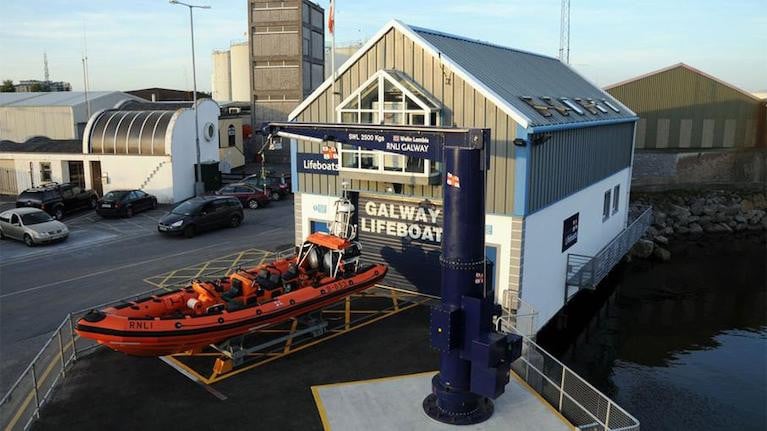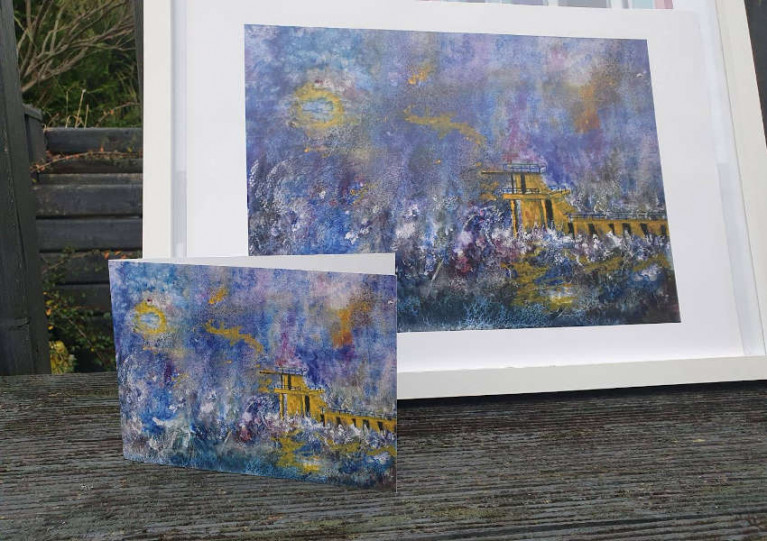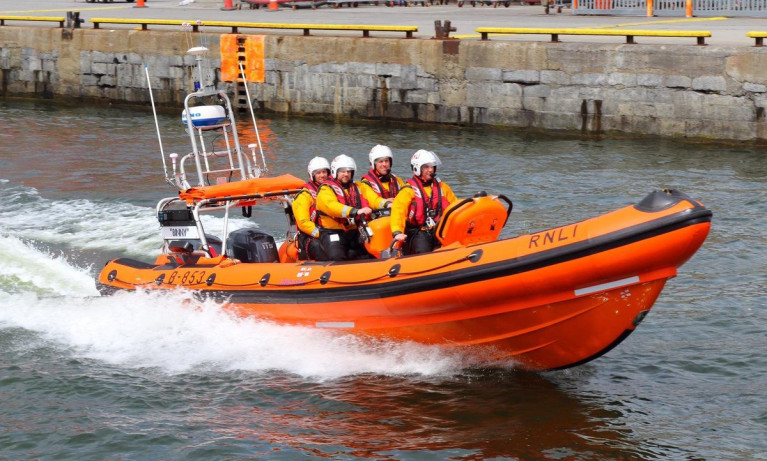Displaying items by tag: Galway
The first sod has been turned on constructing a new pedestrian and cycleway across the river Corrib – the first new bridge over the Atlantic coast river in over 30 years.
The new Salmon Weir crossing will “draw pedestrians and cyclists and facilitate a seamless and natural flow from either side of the river, while creating an iconic focal point for locals and tourists alike”, according to Galway City Council.
The project is funded by the European Commission through the European Regional Development Fund, and the National Transport Authority.
“This world-class bridge will remove current conflicts between pedestrians and cyclists, and traffic, and will enhance links between both sides of the river, as well as facilitating the Cross-City Link public transport corridor over the existing 200-year-old bridge,” Galway city council chief executive Brendan McGrath said.
Minister of State for Transport and Galway West TD Hildegarde Naughton also welcomed the construction.
“Anyone who has, like me, walked across the old bridge, will have been conscious that one slip could lead to a collision given how narrow the footpaths are,” she said.
“ This new shared-use pedestrian and cycle bridge at the Salmon Weir Bridge will bring a number of significant benefits to Galway city, including offering a dedicated safe crossing point for pedestrians and cyclists alike,” Ms Naughton said.
“This is one of over 1,200 projects across the length and breadth of the country to receive targeted funding towards making walking and cycling in our villages, towns and cities safer, more sustainable and enjoyable,” she added.
Planning consent for the new bridge was approved by An Bord Pleanála on August 16th last year, and the construction tender was issued in December.
A contractor was appointed in March of this year, and some advance works, including tree felling, took place before the end of February. Galway City Council anticipates the bridge will be “substantially completed by early 2023”.
A crew of nine were rescued by Galway RNLI last night (Tuesday 24 August) after their RIB ran aground in Ballyvaughan Bay.
With the boat’s propeller and engine damaged, the crew used VHF communications to alert the Irish Coast Guard who immediately sought the assistance of Galway RNLI's inshore lifeboat.
The lifeboat launched from Galway Docks at about 10pm. Conditions were calm and dark when the lifeboat crew located the stricken vessel some 20 minutes later.
All nine crew on board the 6.5m boat were wearing lifejackets and did not need any medical assistance.
Galway RNLI's volunteer lifeboat crew of helm Brian Nilan, James Rhattigan, Dave McGrath and Cathal Bryne took the boat in tow to Parkmore Pier near Kinvara.
Galway RNLI deputy launching authority Seán Óg Leydon said: “The crew of the vessel acted quickly by dropping anchor straight away and contacting the Irish Coast Guard.”
Galway City Council has welcomed An Bord Pleanála’s approval for a new pedestrian and cycle bridge adjacent to the Salmon Weir Bridge over the River Corrib.
The council’s chief executive said the new bridge is a part of its Galway Transport Strategy, which aims to “enhance sustainable travel within the city centre and reduce dependency on the private motor vehicle, in line with national transport and planning policies”.
Brendan McGrath added: “This decision to approve the project is great news, and now allows us to progress it to the next stage.
“This significant development will tie in closely with other projects such as BusConnects Galway, public realm improvements on Newtownsmith and the creation of a civic plaza at the cathedral/Gaol Road.
“These will all work together to create safer spaces for pedestrians and cyclists as they move through the city, as well as a more enjoyable public realm for all.”
The bridge will be co-funded under the European Regional Development Fund with matched funding from the National Transport Authority.
A public consultation on the bridge plans ran last summer via virtual ‘information rooms’ to compensate for the lack of in-person events due to the pandemic.
Following completion of design documents, the construction contract will be opened to tender early next year, the council says.
A local community in eastern Co Mayo rallied to attempt to save as many as 13 common dolphins that live-stranded near Blacksod on Friday (13 August).
As Mayo IWDG’s Facebook reports, the family group comprising 13 dolphins — mainly mothers and calves with a large male — stranded at Tarmon Beach with the tide dropping.
Sadly three of the dolphins died before they could be helped, but the rest responded to being cooled with buckets of seawater by local volunteers assisting the area’s Irish Whale and Dolphin Group (IWDG) members.
As the tide was still dropping for over an hour, it was quickly decided to move the dolphins 2km by road to the slipway at Blacksod where they could be more easily immersed and cared for.
The local IWDG team used their new wheeled dolphin stretcher to transport the larger marine wildlife to a horse box, while the juveniles were carried in beach towels.
Once carefully released back into the water, all were seen to swim quickly and without obvious distress, and by 9pm the pod had left the area.
“Tarmon and the surrounding beaches on the east side of the Mullet Peninsula are notorious for common dolphins live-stranding due to the topography of the beaches,” Mayo IWDG said.
“The beaches are large flat expanses so during spring tides especially, the water can level can drop uniformly and recede up to 1km in parts. Common dolphins being an offshore dolphin species often get caught out on such difficult-to-navigate shallow terrain.
“When a dolphin live-strands it puts immense pressure on their bodies. They can become very disorientated and have muscle spasms from the stranding event making it difficult to swim, which is why this group were given recovery time at Blacksod before being released.
“Thanks again to everyone who helped out today; it was so humbling to see everyone work together to get this pod back to the sea.”
 Juvenile dolphins cooled down with wet towels and seaweed were given recovery time with their pod before release | Credit: Mayo IWDG/Facebook
Juvenile dolphins cooled down with wet towels and seaweed were given recovery time with their pod before release | Credit: Mayo IWDG/Facebook
Elsewhere, the IWDG reports on two separate strandings of Sowerby’s beaked whales in Co Galway. The first was found washed up on Inisbofin at the end of the week while the second was reported yesterday (Saturday 14 August) across the water in Cleggan.
Commenting on the former report, the IWDG said: “Beaked whales are not stranded that frequently but this individual had evidence of rope marks on its body.
“As [they are] an offshore deep-diving species we don’t expect beaked whales to get entangled in fishing gear or interact with offshore activity.
“Maybe these rope marks were not from fishing but some other source. Hard to tell, but without a full post-mortem examination the cause of death will remain speculative.”
Irish Water has been asked to explain why the Connemara harbour of Roundstone may end up with two wastewater treatment plants in a bid to meet EU water quality standards.
As The Times Ireland edition reports, Bord Pleanála has queried why Irish Water would not work with the Industrial Development Authority (IDA) on its plans for a treatment plant instead of opting for its own separate location.
Roundstone’s existing sewerage scheme dates from 1929, discharging wastewater directly into the sea at three locations.
As Afloat reported in March, Irish Water told residents at an information meeting two years ago that treatment would stop the discharge of the equivalent of “645 wheelie bins” daily of wastewater into the bay.
It explained that a proposed plant designed for a population of 1,000 people would comply with the Urban Wastewater Treatment directive.
Irish Water then sought compulsory acquisition of private land to the north of the village, overlooking inner Roundstone Bay.
An oral hearing on this acquisition application was held by An Bord Pleanála in March of this year.
The State body said if its application for the land was approved, it would then seeking planning permission with a target completion date for construction of 2024.
The King family, who are opposing the compulsory acquisition of their property, have accused Irish Water of a lack of transparency.
Some residents have questioned why Irish Water could not cooperate with the IDA on its plans for a treatment plant on State land to the south of the village.
The residents argue that inner bay site is unsuitable, citing data showing a projected increase in sewage discharge from 86 to 106 cubic metres per day - as in a 23% increase.
Local fisherman Pat Conneely has said that the IDA location would be more suitable on an environmental basis than the proposed inner bay location, given that the latter is tidal.
Roundstone Community Council, which has been campaigning for a treatment plant for 20 years, has said it supports the democratic right of local people to object to the choice of location.
In an eight-page letter to Irish Water, An Bord Pleanála refers to an“inconsistency” in its approach and seeks detailed answers to a series of technical questions which must be received by July 7th.
Bord Pleanála notes that Roundstone is on the Wild Atlantic Way - attracting the second-highest landscape rating in the Galway County development plan - and asks Irish Water to comment on “the potential for alternative sites”.
It also asks Irish Water to comment on a recommendation by RPS Consultants that a site to the south of the village – where the IDA has land – is the “only viable” option.
Irish Water confirmed it had “received a number of queries from An Bord Pleanála” and said “the project team are currently reviewing these queries and will submit detailed responses in the coming months in accordance with the timeline requested”.
Read The Times here
The Limerick Trading ketch Ilen has reached Galway in the first stage of a programme which will eventually see her call at all the Irish ports which, in Mediaeval times, were a remarkable mixture of defensive walled towns and actively-functioning seaports. The Irish Walled Towns Network, a grouping operated through the Heritage Council, seeks to emphasise the aspects are shared by those historical port, and the voyage of the Ilen round Ireland, coupled with a wide variety of events at the ports visited, will be tangible evidence of this ancient reality, with the mayor of Limerick, Councillor Michael Collins, aboard Ilen to be greeted on arrive by Galway’s Deputy Mayor, Councillor Colette Connolly.
 The Mayor of Limerick, Councillor Michael Collins, links up with Galway’s Deputy Mayor Colette Connolly at the Ilen in the Port of Galway with Ilen Marine School Director Gary Mac Mahon.
The Mayor of Limerick, Councillor Michael Collins, links up with Galway’s Deputy Mayor Colette Connolly at the Ilen in the Port of Galway with Ilen Marine School Director Gary Mac Mahon.
 Ilen is a fine sight on Galway Bay. Photo: Deirdre Power
Ilen is a fine sight on Galway Bay. Photo: Deirdre Power
Galway to Aran Ferry's Maiden Voyage Today
Weather permitting, a flotilla of wooden-built Galway hookers will escort an aluminium-built passenger ferry out on the first leg of its maiden voyage between Galway city and the Aran islands this morning.
Several gleoiteogs with Galway Hooker Sailing Club aim to accompany the new Aran Island Ferries fast ship out past Mutton island.
As Afloat reported previously, Named Saoirse na Farraige (freedom of the sea), the 400-seat passenger ferry was built in Hong Kong for Aran Island Ferries, the company run by the O’Brien family of An Cheathrú Rua, Co Galway.
It offers a longer sea trip but faster overall journey west from Galway city to Inis Mor.
It is almost 40 years since the O’Briens took their first passengers in the Galway hooker, An Tonaí, and then purchased their first passenger ferry named the Dún Aengus in 1983.
The family company now has a fleet of five-passenger ferries, and their routes between Ros-a-Mhíl and the three Aran islands will be complemented by the new 40-metre ship on the Galway city- Inis Mór route.
The vessel built in Cheoy Lee Shipyards in Hong Kong has a speed of 20 knots, and its master is Donegal man and former pelagic fisherman Shane McCole.
It has a capacity for 394 passengers – as in a 306 passengers on the main deck, divided into two seating areas, and a semi-covered space for 88 passengers on the top deck.
However, the ferry will be carrying reduced capacity to meet with Covid-19 health and safety guidelines.
Passengers leaving for Inis Mór at 9.30am from Galway docks will have the option of a return journey via the Cliffs of Moher in Clare.
The Doolin2Aran Ferries company in Doolin, Co Clare, also offers cruises below the sea cliffs from Doolin pier.
Saoirse na Farraige claims to have “ the cleanest exhaust emission” of any ferry on Irish waters.
It is fitted leather seating, charging points and plasma screens – earning it the local nickname of “GoBus” at sea – and it has a wheelchair lift.
The O’Briens say the new route will create 15 new jobs, after what has been “a tough year for all involved in tourism”.
The Port of Galway has welcomed the first passenger ferry service from the city to the Aran Islands since 2005.
The combined Aran Island Ferries fleet of six vessels has a total facility for 1,420 passengers when at full capacity.
Ticket prices for a return journey on Saoirse na Farraige from Galway docks will be:
Adult: €49, Student/Senior: €44, Child: €25
Galway RNLI Lifeboat Rescue off Seaweed Point
Galway RNLI Lifeboat recovered a casualty from the Seaweed Point causeway off Blackrock, Salthill tonight.
The alert was raised after a member of the public contacted the authorities at about 5 pm.
The caller reported seeing a casualty at Seaweed point, off Blackrock, while out walking in the area.
The Irish Coast Guard requested the assistance of Galway RNLI Lifeboat and a member of the shore crew drove to the scene. Members of Galway Fire Service also assisted.
The lifeboat launched from Galway Docks a short time later and two crew members together with the Fire Service crew went ashore and carried the casualty on to the vessel.
He was transported back to the lifeboat station at Galway docks, where Gardai and the RNLI lifeboat medical officer assisted.
Galway Corinthians RFC Raise Over €8,500 for Galway RNLI & Cancer Care West
What started as a small fundraiser for Galway RNLI and Cancer Care West has turned into something spectacular as the players and members of Galway Corinthians RFC have raised over €8,500 for both organisations through two fundraising efforts.
The first featured the senior players in the club with Jack Noone and Kenneth Casburn behind the organisation of ‘Movember’ where players, management and committee members grew facial hair of some kind for the month of November.
The second featured the mercurial talents of club president Kieran Faherty.
Known fondly as ‘Flash’, Kieran is an accomplished artist and he generously provided one of his paintings known as ‘Brewing Up A Storm’, a stunning view of Galway Bay that has proved very popular with prints and cards selling out quickly.
But what inspired the painting? “I am often asked that,” Kieran says. “Pretty much my signature pieces are all about colour, and Connemara is my inspiration for many.
“As a kid I only saw greyness in the Connemara landscape, but age opens your eyes. Now I embrace all the wonderful changing coloured landscape that the mountains, bogs and lakes give up to us.”
He added: “I think my inspiration for this piece is the challenges it offers, as it sits in stormy waters, and I think appropriately it is raising funds for a charity that lives in stormy waters with their incredible brave crew.”
The fundraising has been warmly welcomed by both organisations, with Mike Swan, Galway RNLI lifeboat operations manager, saying: “I wanted to express my personal gratitude for the effort of the members of Corinthians Rugby Club and thank them for their very generous donation, of which will be put to good use saving lives at sea.
“Given the year that’s in it, the crew are overwhelmed with the support from the people of Galway.”
Galway RNLI Rescues Man Caught in Rising Tide
In Galway city, the RNLI inshore lifeboat rescued a man caught in rising tide while out walking at Ballyloughane beach near Renmore.
A member of the public spotted the man who had taken refuge on Hare island at about 11 am, and the alarm was raised with the Irish Coast Guard.
Galway lifeboat launched within minutes and took the man safely on board at Hare island, bringing him back to Galway docks. He did not require medical attention.
Galway lifeboat launch authority Mike Swan urged the public “ to be aware of the tide times and to take extra care when out walking any of the coastal areas around the bay so as not to get caught out”.
“Thankfully this ended well,” he said.
The Galway RNLI crew on the callout were helmsman Declan Killilea, with Stefanie Carr, Greg Cullen and Olivia Byrne.

































































